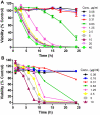SCYX-7158, an orally-active benzoxaborole for the treatment of stage 2 human African trypanosomiasis
- PMID: 21738803
- PMCID: PMC3125149
- DOI: 10.1371/journal.pntd.0001151
SCYX-7158, an orally-active benzoxaborole for the treatment of stage 2 human African trypanosomiasis
Abstract
Background: Human African trypanosomiasis (HAT) is an important public health problem in sub-Saharan Africa, affecting hundreds of thousands of individuals. An urgent need exists for the discovery and development of new, safe, and effective drugs to treat HAT, as existing therapies suffer from poor safety profiles, difficult treatment regimens, limited effectiveness, and a high cost of goods. We have discovered and optimized a novel class of small-molecule boron-containing compounds, benzoxaboroles, to identify SCYX-7158 as an effective, safe and orally active treatment for HAT.
Methodology/principal findings: A drug discovery project employing integrated biological screening, medicinal chemistry and pharmacokinetic characterization identified SCYX-7158 as an optimized analog, as it is active in vitro against relevant strains of Trypanosoma brucei, including T. b. rhodesiense and T. b. gambiense, is efficacious in both stage 1 and stage 2 murine HAT models and has physicochemical and in vitro absorption, distribution, metabolism, elimination and toxicology (ADMET) properties consistent with the compound being orally available, metabolically stable and CNS permeable. In a murine stage 2 study, SCYX-7158 is effective orally at doses as low as 12.5 mg/kg (QD×7 days). In vivo pharmacokinetic characterization of SCYX-7158 demonstrates that the compound is highly bioavailable in rodents and non-human primates, has low intravenous plasma clearance and has a 24-h elimination half-life and a volume of distribution that indicate good tissue distribution. Most importantly, in rodents brain exposure of SCYX-7158 is high, with C(max) >10 µg/mL and AUC(0-24 hr) >100 µg*h/mL following a 25 mg/kg oral dose. Furthermore, SCYX-7158 readily distributes into cerebrospinal fluid to achieve therapeutically relevant concentrations in this compartment.
Conclusions/significance: The biological and pharmacokinetic properties of SCYX-7158 suggest that this compound will be efficacious and safe to treat stage 2 HAT. SCYX-7158 has been selected to enter preclinical studies, with expected progression to phase 1 clinical trials in 2011.
Conflict of interest statement
The authors have declared that no competing interests exist.
Figures





References
Publication types
MeSH terms
Substances
LinkOut - more resources
Full Text Sources
Other Literature Sources

